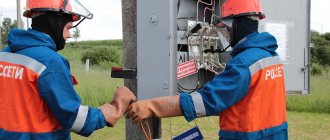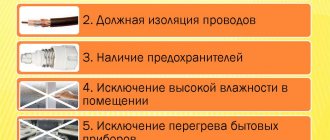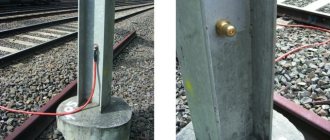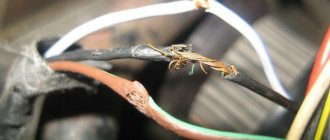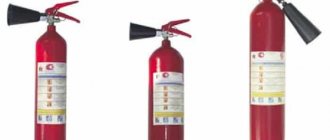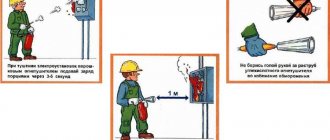03. Occupational safety during operational maintenance and inspection of electrical installations.
Home → Order on approval of labor safety rules during the operation of electrical installations dated July 24, 2013 N328н → 03. Occupational safety during operational maintenance and inspection of electrical installations.
3.1. Operational switching must be carried out by workers engaged in operational management and maintenance of electrical installations (inspection, operational switching, preparation of the workplace, admission and supervision of workers, performance of work in the order of routine operation) (hereinafter referred to as operational personnel), or workers specially trained and prepared for operational maintenance in the approved volume of electrical installations assigned to him (hereinafter referred to as operational and repair personnel), admitted to the work of operational and operational activities of an organization or a separate unit.
3.2. In electrical installations with voltages above 1000 V, employees from among the operational personnel who solely service electrical installations and shift supervisors must have electrical safety group (hereinafter referred to as group) IV, the rest of the workers on the shift must have group III.
In electrical installations with voltages up to 1000 V, employees from among the operational personnel who solely service electrical installations must have group III.
The type of operational maintenance of electrical installations, as well as the number of operational personnel per shift, is established by the operational regulations of the organization or a separate unit.
3.3. During operational maintenance, inspections of electrical installations, as well as performing work in electrical installations, the approach of people, hydraulic lifts, telescopic towers, excavators, tractors, forklifts, drilling and crane machines, mechanically driven retractable ladders (hereinafter referred to as mechanisms) and technical devices of cyclic action is not allowed. for lifting and moving loads (hereinafter referred to as lifting machines) to live, unprotected live parts at distances less than those specified in Table No. 1.
3.4. A single inspection of an electrical installation, the electrical part of the process equipment has the right to be carried out by an employee from among the operational personnel, having a group of at least III, servicing this electrical installation during working hours or on duty, or by an employee from among the administrative and technical personnel (managers and specialists entrusted with responsibilities for organizing technical and operational maintenance, carrying out repair, installation and commissioning work in electrical installations (hereinafter referred to as administrative and technical personnel) with group V - for electrical installations with voltages above 1000 V, and an employee with group IV - for electrical installations with voltages up to 1000 V The right of sole inspection is granted on the basis of the operational regulations of the organization (separate division).
Table No. 1 Permissible distances to live parts of electrical installations that are energized.
| Electrical installation voltage, kV | Distance from workers and the tools and devices they use, from temporary fences, m | Distances from mechanisms and lifting machines in working and transport positions from slings, lifting devices and loads, m |
| VL up to 1 | 0,6 | 1,0 |
| Other electrical installations: | ||
| up to 1 | not standardized (no touching) | 1,0 |
| 1 — 35 | 0,6 | 1,0 |
| 60- 110 | 1,0 | 1,5 |
| 150 | 1,5 | 2,0 |
| 220 | 2,0 | 2,5 |
| 330 | 2,5 | 3,5 |
| 400- 500 | 3,5 | 4,5 |
| 750 | 5,0 | 6,0 |
| 1150 | 8,0 | 10,0 |
Inspection of overhead power lines (devices for transmitting electricity through wires located in the open air and attached using insulators and fittings to supports or brackets and racks on engineering structures (bridges, overpasses) (hereinafter referred to as overhead lines) must be carried out in accordance with the requirements of paragraphs 7.15 , 38.71, 38.72, 38.73 Rules The beginning and end of an overhead power transmission line are taken to be linear portals or linear inputs of an electrical installation that serves for receiving and distributing electricity and containing switching devices, prefabricated and connecting busbars, auxiliary devices (compressor, battery), as well as devices protection, automation and measuring instruments (hereinafter referred to as switchgear), and for branches - a branch support and a linear portal or linear input of the switchgear.
RU are:
- open (hereinafter - ORU) - RU, where all or the main equipment is located in the open air;
- closed (hereinafter - closed switchgear) - switchgear, the equipment of which is located in the building;
- complete (hereinafter referred to as switchgear) - switchgear, consisting of fully or partially closed cabinets or units with built-in devices, protection and electrical automation devices, supplied assembled or fully prepared for assembly.
3.5. Workers who do not service electrical installations may be allowed into electrical installations accompanied by operational personnel servicing this electrical installation, who have group IV - in electrical installations with voltages above 1000 V, and who have group III - in electrical installations with voltages up to 1000 V, or an employee who has the right of sole inspection.
The accompanying worker must monitor the safety of people allowed into electrical installations and warn them not to approach live parts.
3.6. When inspecting electrical installations, it is allowed to open the doors of switchboards, assemblies, control panels and other devices. When inspecting electrical installations with voltages above 1000 V, it is not allowed to enter rooms or chambers that are not equipped with fences or barriers that prevent approaching live parts at distances less than those specified in Table No. 1. It is not allowed to penetrate the fences and barriers of electrical installations.
No work is allowed to be performed during the inspection.
3.7. When there is a ground fault in electrical installations with a voltage of 3 - 35 kV, approaching the place of the fault to a distance of less than 4 m in closed switchgear and less than 8 m in open switchgear and on overhead lines is allowed only for operational switching in order to eliminate the short circuit and free people caught under voltage. In this case, you should use electrical protective equipment.
3.8. In case of accidents, in order to free the victim from the action of electric current, the voltage must be removed immediately without prior permission from the operating personnel.
3.9. Turn off and turn on electrical devices intended for switching the electrical circuit and relieving voltage from part of the electrical installation (switch, load switch, separator, disconnector, circuit breaker, circuit breaker, batch switch, fuse) (hereinafter referred to as switching devices) and grounding switches (grounding disconnectors, grounding knives ) voltages above 1000 V with manual drive require dielectric gloves.
3.10. Removing and installing fuses should be done when the voltage is removed.
It is allowed to remove and install fuses that are energized, but without load.
Under voltage and under load it is allowed to replace:
- fuses in control, electrical automation, blocking, measurement, relay protection, monitoring and alarm circuits (hereinafter referred to as secondary connections or circuits);
- voltage transformer fuses;
- plug type fuses.
3.11. When removing and installing live fuses, you must use:
- in electrical installations with voltages above 1000 V - with insulating clamps (rod) using dielectric gloves and means of protecting the face and eyes from mechanical influences and thermal risks of an electric arc;
- in electrical installations with voltages up to 1000 V - insulating pliers, dielectric gloves and means of protecting the face and eyes from mechanical influences and thermal risks of an electric arc.
3.12. The doors of electrical installation rooms, chambers, switchboards and assemblies, except those in which work is carried out, must be locked.
3.13. The procedure for storing and issuing keys to electrical installations is determined by order of the head of the organization (separate unit). Keys to electrical installations must be registered with operating personnel. In electrical installations that do not have local operating personnel, the keys may be registered with administrative and technical personnel.
Keys to electrical installations must be numbered and kept in a locked box. One set should be a spare. The issuance of keys must be certified by the signature of the employee responsible for issuing and storing the keys, as well as the signature of the employee who received the keys.
Keys to electrical installations must be issued to:
- employees who have the right of sole inspection, including operational personnel, from all premises, input devices, panels and shields;
- the person admitting from among the operational personnel, the responsible work manager and the work foreman, who supervises the admission to work according to the work permit, orders from the premises, input devices, panels, shields in which work is to be done;
- operational or operational-repair personnel during work performed in the order of routine operation of the premises in which they are to work, input devices, panels and shields.
Keys must be returned daily upon completion of inspection or work.
When working in electrical installations that do not have local operating personnel, keys to electrical installations must be returned no later than the next working day after inspection or complete completion of work.
The employer must ensure records of the issuance and return of keys to electrical installations.
Return to Order
Safety measures when servicing electrical installations
9. Work in electrical installations with regard to safety measures is divided into the following categories;
1) with stress relief;
2) without relieving voltage on live parts and near them;
3) without removing the voltage, away from live parts that are energized.
When simultaneously working in electrical installations with voltages up to and above 1000 V, the categories of work are determined in relation to electrical installations with voltages above 1000 V.
10. Work performed with voltage relief includes work that is carried out in an electrical installation (or part of it) in which the voltage has been removed from all live parts and the entrance to the room of an adjacent electrical installation that is energized is locked.
11. Work performed without relieving voltage on live parts and near them includes work performed directly on these parts.
In electrical installations with voltages above 1000 V, as well as on overhead power lines (VL) with voltage up to 1000 V, the same work includes work performed at distances from live parts less than: up to 1000 V on VL - 0.6 m from people and used tools, from temporary fences and 1 m from mechanisms and lifting machines in working and transport positions, from slings of lifting devices and loads up to 1000 V in switchgear without touching
normalized; 3 -35 kV -0.6 m from people and 1 m from machinery; 60 - 110 kV - 1 m from people and 1.5 m from machinery, 220 kV - 2 m from people and 2.5 m from machinery.
Work without relieving voltage on live parts and near them must be performed by at least 2 persons, of whom the work performer must have an electrical safety group of at least IV, the rest - not lower than III.
12. Work without voltage relief away from live parts that are energized is considered to be work in which accidental approach of working people and the repair equipment and tools they use to live parts is excluded at a distance less than specified in the previous paragraph and the adoption of technical or organizational measures is not required (eg continuous surveillance) to prevent such an approach.
In electrical installations with voltages above 1000 V, work without removing the voltage on live parts and near them must be carried out using protective equipment to isolate a person from live parts or from the ground. When isolating a person from the ground, work must be carried out in accordance with special instructions or technological maps, which provide the necessary safety measures.
13. When working in electrical installations with voltages above 1000 V without removing the voltage on live parts and near them, you must:
1) protect other live parts located near the workplace that are energized and that may be accidentally touched;
2) work in dielectric galoshes or standing on an insulating stand or on a dielectric mat;
3) use tools with insulating handles (screwdrivers, in addition, must have an insulated rod); if such a tool is not available, use dielectric gloves.
14. When carrying out work without relieving voltage on live parts using insulating protective equipment, it is necessary to:
1) hold the insulating parts of the protective equipment by the grip handles up to the restrictive ring;
2) arrange the insulating parts of the protective equipment so that there is no danger of overlap along the insulation surface between the current-carrying parts of two phases or a ground fault;
3) use only dry and clean insulating parts of protective equipment with an intact varnish coating.
If damage to the varnish coating or other malfunctions of the insulating parts of the protective equipment is detected, their use must be stopped immediately.
15. When working with the use of electrical protective equipment (insulating rods and clamps, electrical clamps, voltage indicators), it is allowed
the approach of a person to live parts at a distance determined by the length of the insulating part of these means.
16. Without using electrical protective equipment, it is prohibited to touch the insulators of an electrical installation that is energized.
17. In electrical installations, it is prohibited to work in a bent position if, when straightened, the distance to live parts is less than that specified in clause 11. When working near unprotected live parts, it is prohibited to position yourself so that these parts are at the back or on both sides.
18. Scaffolds and ladders used for repair work must have a smooth, planed surface; painting the ladders with paints is prohibited.
Stairs after manufacture or repair are tested with a static load of 1500 N (150 kgf) and then during operation with a load of 1200 N
(120 kgf). When testing, the specified load is applied for 2 minutes. to one of the steps in the middle of the flight of stairs, installed at an angle of 75 degrees to the horizontal plane. The testing period for ladders depends on the conditions of their use, but less than once a year. Before work, it is necessary to check the serviceability of the ladder. It is prohibited to work on a faulty ladder (stepladder). The steps of wooden ladders and stepladders must be firmly inserted into the hollowed holes in the strings. The distance between steps should not exceed 0.4 m. Bowstrings should be fastened with tie bolts at least every 2 m, as well as under the upper and lower steps. It is prohibited to use ladders and stepladders with steps sewn with nails without first inserting them. The lower ends of ladders must have stops in the form of sharp plug-in tips when installed on the ground or rubber tips when installed on the floor, asphalt, etc.
The total length of a wooden ladder must not exceed 5 m. The ladder must be equipped with a device to prevent the possibility of shifting. At the lower ends of the extension ladder there must be fittings with sharp metal tips for installation on the ground, and when using ladders on smooth surfaces (parquet, metal, concrete, etc.) they must have rubber tips on them.
The upper ends of the ladder must rest securely on a strong support.
The upper ends of ladders attached to pipes or wires must be equipped with special hooks - grips that prevent the ladder from falling due to wind and accidental shocks.
Suspended ladders used to work on structures and wires must have devices that ensure their strong fastening.
Splicing of wooden ladders is allowed only by firmly connecting them with metal clamps, plates with bolts, etc. Joining more than two wooden ladders is prohibited.
When servicing and repairing electrical installations, the use of metal ladders is prohibited. Work using ladders is performed by two persons, one of whom is below and insures the second.
Working with boxes and other foreign objects is prohibited.
19. Work on overhead lines involving touching a wire lowered from a support down to the ground must be carried out using electrical protective equipment (gloves, rods) or from a metal platform connected to equalize the potential by a conductor with this wire. It is allowed to carry out work from the ground without the use of electrical protective equipment, provided that grounding is applied to the wire in close proximity to each point of contact, but no further than 3 m from working people.
20. When a thunderstorm approaches, all work on overhead lines, inputs and switching equipment directly connected to overhead lines must be stopped.
21. During fog and rain, work requiring the use of protective insulating equipment is prohibited.
Personnel should remember that after voltage has disappeared from the electrical installation, it may be reapplied without warning.
Installation and removal of fuses are usually carried out with the voltage removed. Under voltage, but without load, it is prohibited to remove and install fuses on connections in which there are no switching devices in the circuit
22. Under voltage and under load, it is allowed to remove and install fuses of voltage transformers and closed-type fuses in electrical installations with voltages up to 1000 V.
23. When removing and installing live fuses, you must use:
1) in electrical installations with voltages above 1000 V, use insulating clamps, dielectric gloves and safety glasses (mask);
2) in electrical installations with voltages up to 1000 V, use insulating pliers or dielectric gloves, and in the presence of open fuse links, and safety glasses (mask).
24. In electrical installations up to 1000 V AC with an isolated neutral, grounding or protective disconnection must be performed as a protective measure.
Parts to be grounded include:
1) housings of electrical machines, transformers, devices, lamps, etc.;
2) frames of distribution boards, control panels, lighting and power cabinets;
3) metal structures of distribution boards;
4) metal cases of mobile and portable electrical receivers.

